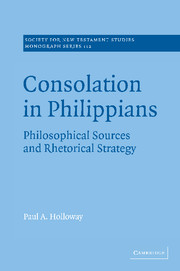Book contents
- Frontmatter
- Contents
- Acknowledgments
- Abbreviations
- Introduction
- Part I Literary and rhetorical contexts
- 1 The integrity of Philippians
- 2 The rhetorical situation of Philippians
- 3 On the genre of Philippians: ancient consolation
- Part II Consolation in Philippians
- Conclusion: an analysis of Philippians
- Bibliography
- Index of modern authors
- Index of passages cited
1 - The integrity of Philippians
Published online by Cambridge University Press: 06 October 2009
- Frontmatter
- Contents
- Acknowledgments
- Abbreviations
- Introduction
- Part I Literary and rhetorical contexts
- 1 The integrity of Philippians
- 2 The rhetorical situation of Philippians
- 3 On the genre of Philippians: ancient consolation
- Part II Consolation in Philippians
- Conclusion: an analysis of Philippians
- Bibliography
- Index of modern authors
- Index of passages cited
Summary
The literary integrity of Philippians is much debated and must be discussed prior to any study of the letter. It is particularly relevant to our study which argues that the prayer-report of Phil. 1:9–11 is programmatic for the argument of each of the alleged letter-fragments and gives to the canonical letter both a logical and a thematic unity. In this initial chapter we shall examine the case for partitioning. We shall argue that it has not been successfully made and that, on the evidence, it is reasonable to approach Philippians as a unity.
Modern critical reconstructions of Philippians have typically understood it to be a composite of three separate letters, the first two of which at least were written while Paul was in prison. These are, in chronological order: Letter A (4:10–20), a short thank-you note sent immediately after the arrival of Epaphroditus with a gift from the Philippians; Letter B (1:1–3:1), a letter of reassurance sent upon the return of Epaphroditus; and Letter C (3:2–4:3), a polemical letter or Kampfbrief sent at some later date (perhaps after his release) when Paul had become more fully apprised of the theological dangers facing the Philippians. The remaining material in 4:4–9 and 4:21–3 is variously assigned, though usually 4:4–7 and 21–3 are assigned to Letter B. Evidence adduced in support of this hypothesis falls into three categories: (1) various pieces of external evidence suggesting either directly or indirectly that Philippians is a composite; (2) internal evidence pointing to 3:2–4:3 as the fragment of a separate letter; and (3) further internal evidence pointing to 4:10–20 as another fragment. We shall consider these in order.
External evidence that Philippians is a composite
The evidence for partitioning Philippians is primarily internal.
- Type
- Chapter
- Information
- Consolation in PhilippiansPhilosophical Sources and Rhetorical Strategy, pp. 7 - 33Publisher: Cambridge University PressPrint publication year: 2001
- 1
- Cited by



